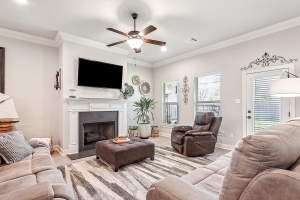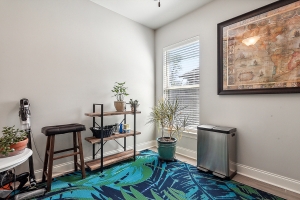Taking the Leap into Homeownership: A Beginner’s Guide
Buying a house is more than an investment; it’s a cornerstone of the American dream. It’s easy to see homeownership as a distant goal, something to achieve in the far-off future. However, with thoughtful planning and the right guidance, you can embark on this exciting journey sooner than you might think.
Embarking on the path to homeownership is a process of discovery, learning, and growth. Each step forward is a building block, not just towards a house, but a home where memories will be made and futures will unfold. And if ever you find yourself at a crossroads, professional help is just a phone call or email away. Real estate agents specialize in guiding first-time buyers through the labyrinth of buying a home.
Here’s your roadmap for a smooth start to homeownership:
Build a Strong Credit Foundation
Good credit is the bedrock of buying a home. It unlocks the doors to better mortgage rates and could save you a significant sum over the life of your home loan. Focus on paying down high-interest debts, and steer clear of taking on new financial burdens, like a hefty car loan.
Gather Essential Financial Documents
A clear financial picture is crucial when approaching lenders. Be prepared with recent pay stubs, tax returns from the past two years, and any other documents that depict your earnings. For those with variable income or past financial hiccups, be ready to present a comprehensive income history and explain any blips in your financial past.
Craft a Realistic Budget
Scrutinize your monthly expenses and income to determine your spending power for housing costs. Aim to find expenses you can trim to bolster your down payment savings. Keep in mind the golden rule: housing shouldn’t consume more than 30% of your monthly income.
Connect with a Real Estate Agent
A trusted real estate agent should be one of your first allies. They’ll help crystallize your housing needs and set practical expectations. Your agent is more than a guide; they’re your advocate, ready to answer questions and navigate you to a successful closing.
Get Prequalified for a Mortgage
Prequalification is an early step in your home-buying journey where a lender evaluates your finances to estimate how much they might lend you. This is a strategic move, especially in competitive markets where you need to act fast and show sellers you’re serious.
Identify Your Home Essentials
What does your ideal home look like? Have each household member list their top five must-haves. This wishlist will help concentrate your search on properties that meet your collective criteria, filtering out unsuitable options right off the bat.
Explore Homes and Neighborhoods
With your agent’s insights and your own research, delve into neighborhoods that align with your lifestyle and budget. Make the most of weekends by visiting open houses and scheduling tours. This hands-on approach is not only practical but can also be an enjoyable part of the process.
Invest in a Home Inspection
A thorough home inspection is indispensable, providing a detailed overview of the home’s condition. Be wary of homes with significant electrical, plumbing, or structural issues, as some first-time buyer mortgage programs won’t cover homes with severe defects.
While buying a house might seem overwhelming at first, it’s more approachable than it appears. Each step, each decision, brings you closer to holding the keys to your own home. With the right preparation and support, you can demystify the process and enjoy the excitement that comes with purchasing your first home. It’s not just about finding a place to live; it’s about creating a personal haven where your life unfolds.
Embracing Minimalism: The Art of Living with Less
In the whisper-quiet corridors of modern design, minimalism has emerged as more than just an aesthetic; it has become a philosophy, a way of life that champions the beauty of less. The minimalist movement, characterized by the stripping away of the superfluous, seeks to find freedom through simplicity. It’s a concept that invites us to look beyond the clutter and find tranquility and intentionality in our spaces and, by extension, in our lives.
At the heart of minimalism lies the principle of intentionality. Every object within a minimalist space is chosen with purpose and care. Rather than rooms crowded with unused items, minimalism favors spaces that breathe freely. It’s the thoughtfully selected sofa that offers both comfort and style, or the single piece of abstract art that speaks volumes from a clean, white wall. The design is not just about visual appeal but about crafting an environment that nurtures calmness and inspires clarity.
The minimalist home is often seen as a reflection of the mind. The absence of disorder and excess can pave the way for peace and productivity. A minimalist room, devoid of distraction, commands a certain kind of presence, asking those who enter to fully engage with the space, to appreciate the interplay of light and shadow, and the subtle elegance of the materials used. The neutral color palette often employed in minimalist design acts as a canvas, where the drama of daily life can unfold without competition from its surroundings.
Embracing minimalism also means embracing sustainability. In a world increasingly burdened by consumption, choosing to live with less is a quiet act of rebellion. It is a conscious decision to stop the endless cycle of buying and discarding, to find beauty and satisfaction in what we already possess. This philosophy extends beyond the walls of the home and into every aspect of life, encouraging a thoughtful approach to consumption, where quality triumphs over quantity, and longevity is valued over the fleeting allure of the new.
The journey towards a minimalist lifestyle can be both liberating and challenging. It asks us to examine what we truly need, to differentiate between desire and necessity. This path is not about deprivation but about finding richness in simplicity. As we peel away the layers of material excess, we often uncover hidden treasures: more time, more space, and a greater sense of well-being.
Minimalism, therefore, is not just an aesthetic to be admired but a pathway to a more mindful and sustainable existence. In our hectic, modern lives, where the clamor for our attention is relentless, the minimalist ethos offers a sanctuary of simplicity. It is a whisper among the shouts, reminding us that sometimes, the most profound statement is the one that speaks in silences.
Choosing the Best Home Insurance for Veterans: Insights from Experts
When it comes to selecting the right home insurance, veterans have unique needs and deserve a service that acknowledges their contribution to our nation. The best home insurance for veterans is not merely about coverage and cost but is deeply rooted in trust, understanding, and tailored services that recognize their specific circumstances.
Identifying the Best: Beyond the Basics
Most insurance carriers offer similar products, making it challenging to distinguish the best fit for veterans. The key to selecting the right insurance lies in understanding the subtle differences. Veterans should consider several questions when evaluating insurance options:
– Who can I contact for questions or policy changes?
– Who assists when filing a claim or moving?
– Is there continuity in whom I deal with?
Having a known point of contact simplifies processes and builds a rapport based on trust and reliability – crucial elements when handling something as significant as home insurance.
The Importance of Trust
Trust is the cornerstone of the best home insurance for veterans. A trustworthy provider values transparency, fairness, and dependability. Veterans should look for insurers that not only offer financial value but also demonstrate a genuine commitment to serving their clients, especially during challenging times.
Specialization in Serving Veterans
While many companies may claim to serve veterans well, those that primarily cater to the military community often provide a more personalized and understanding service. An insurer’s focus on veterans and active-duty members can significantly impact the relevance and quality of the services and support provided.
Smaller Might Be Better
In the world of home insurance, bigger is not always better, especially for veterans. A smaller, community-oriented company that has served the military community for years, such as Armed Forces Insurance, can offer more personalized services than larger, impersonal corporations. These companies understand the unique challenges and lifestyles of military personnel and veterans.
Making the Decision
Ultimately, the choice of the best home insurance is a personal one for veterans. It involves weighing the value, understanding the insurer’s commitment to the military community, and deciding who you want by your side during life’s unexpected challenges.
Armed Forces Insurance: Over a Century of Trust
For more than 135 years, Armed Forces Insurance has been a trusted advisor to the American armed forces community. Unlike large corporate entities, Armed Forces Insurance offers a personal touch, situated near Fort Leavenworth in Kansas, ensuring that they know their customers and understand their needs. For veterans seeking a reliable, understanding, and specialized insurance provider, Armed Forces Insurance represents a choice worth considering.
In conclusion, when searching for the best home insurance, veterans should look for providers that offer transparency, are tailored to the military lifestyle, and have a long-standing reputation for serving the armed forces community. Remember, the right insurance is not just about coverage; it’s about peace of mind and having a trusted advisor by your side.
Beyond the Mortgage: Understanding the True Cost of Homeownership
Homeownership symbolizes a pivotal achievement for many, embodying the culmination of dreams, aspirations, and hard work. However, the landscape of owning a home extends beyond the monthly mortgage payments that often capture the spotlight in affordability discussions. The tapestry of homeownership is woven with various other expenses that, when overlooked, can unravel the dream into an unexpected financial burden. Here’s an in-depth exploration of the often-overlooked facets of homeownership costs, equipping you with the knowledge to navigate this complex terrain.
1. Property Taxes: The Unseen Hand
A homeowner’s journey is perennially accompanied by property taxes, a significant and ongoing fiscal responsibility that escalates with the value of your residence. This tax is determined by the assessed value of your property and local tax rates, potentially integrating into your monthly mortgage payments for easier management. Understanding this component is crucial for forecasting long-term expenses.
2. Home Insurance: The Shield of Security
Protecting your home, the sanctuary of your dreams and memories, is paramount. Home insurance emerges as the shield against unforeseen damages, a non-negotiable for mortgage holders and a wise choice for outright owners. Navigating this arena involves balancing comprehensive coverage with affordable premiums, a task necessitating diligent research and comparison.
3. Utilities: The Pulse of the Home
Transitioning from tenant to homeowner transforms you into the master of all utilities—electricity, gas, water, and beyond. These essential services breathe life into your home, with costs fluctuating based on size, location, and usage. Embracing energy conservation can mitigate these inevitable expenses.
4. Maintenance and Repairs: The Continuous Commitment
The stewardship of a home demands a commitment to regular maintenance and readiness for the unforeseen. From the tranquility of a well-kept garden to the tumult of a sudden leak, the spectrum of home upkeep is vast. Cultivating a savings reserve for these inevitable occurrences ensures that your home remains a source of comfort rather than stress.
5. Homeowner’s Association (HOA) Fees: The Community Contribution
For many, the homeownership experience is intertwined with a Homeowner’s Association. While these fees support communal harmony and amenities, they also add a layer to the financial landscape of homeownership. Thoroughly understanding these obligations before committing to a property can prevent future surprises.
6. Appliances and Furniture: The Accoutrements of Comfort
The initial euphoria of acquiring a new home often leads to the realization of the need for appliances and furniture—a one-time but substantial expenditure. Anticipating these costs allows for a smoother transition and avoids the discomfort of an underfurnished abode.
7. Home Improvement Projects: The Vision of Enhancement
Many homeowners are driven by the desire to mold their spaces to reflect personal tastes or to augment the property’s value. Home improvement projects, from minor updates to major renovations, require judicious planning and budgeting to ensure they enhance rather than encumber your financial health.
8. Home Security: The Investment in Peace
In an era where safety is paramount, investing in home security systems or smart home technology is an increasingly common consideration for homeowners. While optional, the peace of mind and protection offered are invaluable assets to many.
In Conclusion
The dream of homeownership is not one to be embarked upon lightly, nor without comprehensive preparation. Beyond the threshold of mortgage payments lies a multifaceted realm of financial responsibilities. By delving into these aspects, aspiring homeowners can arm themselves with the foresight and budgeting acumen necessary to navigate the waters of homeownership successfully. Understanding the full spectrum of homeownership costs is not just about safeguarding your investment—it’s about ensuring that your home remains a source of joy, security, and pride.

